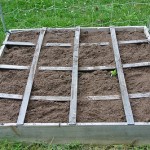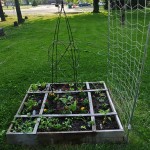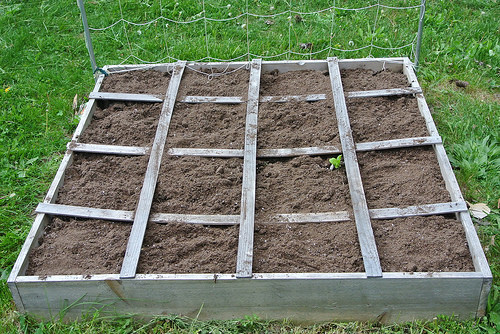Writer / Jane VanOsdol
Based on my childhood, my dad would have never believed that I would turn into a gardener. I did whatever I could to avoid the large vegetable patch thriving in our Michigan back yard. Weeding was my most dreaded chore, so I’d disappear when I saw Dad head out to the back 40.
Somewhere along the way, I changed.
Gardening must have been in my blood all along, because I took to it, even persuading my father-in-law to let me dig up a plot for strawberries from his carefully tended and pampered yard. Something about growing my own food that wasn’t laden with chemicals and tasted way better than grocery store fare resonated with me. I didn’t realize how lucky I was until I moved to Central Indiana and stuck a shovel in the rock-hard, impacted clay “soil” that was my back yard. For years I have tilled, amended, watered, and halfheartedly weeded my plot with varying results.
Square Foot Gardening
 Last year I was frustrated enough to try something new. I ran across Mel Bartholomew’s All New Square Foot Gardening book, bought it, read it, and tried it. Gone are long rows, thinning seedlings, and harvesting in bulk. Square foot gardening is all about efficiency and convenience for the home gardener, not the farmer growing for the masses. Here are the basics:
Last year I was frustrated enough to try something new. I ran across Mel Bartholomew’s All New Square Foot Gardening book, bought it, read it, and tried it. Gone are long rows, thinning seedlings, and harvesting in bulk. Square foot gardening is all about efficiency and convenience for the home gardener, not the farmer growing for the masses. Here are the basics:
*Raised beds are typically 4 x 4 and filled to a depth of 6 inches with Mel’s Mix.
*Each bed contains a grid that splits the bed into 16 12-inch squares.
*Depending upon the size of the mature plant, squares are planted with either 1, 4, 9, or 16 plants/seeds per square foot.
*Vertical frames help support vining crops.
*Maximum output and minimum waste (of space or seeds) is the focus.
Best of all, you’ll spend almost no time weeding.
My Results
The most time-consuming part of the process is building the beds and vertical frames, and mixing the growing medium. This is easily a weekend (perhaps even a one-day) project if you have help. The plans are simple and once it’s done, it’s done. It will last for years. I had the most trouble finding vermiculite (coarse grade in 4-cubic-foot bags) for Mel’s Mix. No one seemed to carry it. You can order it online, but plan ahead for that. Once I had everything assembled, I dumped all the mixtures on a big tarp, mixed it, and recruited my son to shovel it into the beds. I was then ready to plant!
I was amazed at how much I was able to plant in my boxes: tomatoes, melons, cucumbers, green beans, peppers, lettuce, mesclun, Swiss chard, spinach, onions, radishes, herbs, and flowers. My husband was dubious about the green beans, but we wound up with an abundant crop. Everything flourished, including the vining plants. The melons actually grew up the trellis, and I secured them with twine. Unfortunately, they presented my one problem of the year: they contracted a fungus, so I only harvested one melon. On the plus side, I had very little weeding and everything else grew prolifically. The only thing I have to do to prepare for this planting season is to add compost, and I am ready to go.
Who Shouldn’t Do Square Foot Gardening?
 If you are an avid canner/freezer, you’ll either want to do a traditional garden or you’ll want to make extra square foot beds. I’d opt for the beds because there is so little maintenance. Overall, the plan is customizable, and the book is full of ideas from succession crops to extending the growing season to protecting your crop from critters.
If you are an avid canner/freezer, you’ll either want to do a traditional garden or you’ll want to make extra square foot beds. I’d opt for the beds because there is so little maintenance. Overall, the plan is customizable, and the book is full of ideas from succession crops to extending the growing season to protecting your crop from critters.
I am hooked on square foot gardening and have already started this year’s crops. Happily, I’ve inherited my dad’s love of gardening and found a way to still avoid my dreaded chore of weeding. Happy planting!





